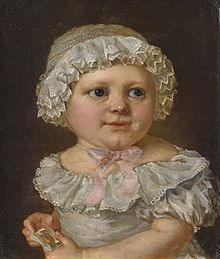Clothing fashion of the restoration and the Biedermeier
During the time of the so-called restoration , the view of women's fashion also changed, and from around 1820 a return to old forms began.
Womenswear
restoration



During the period of the so-called Restoration , the fashion of the Empire period was largely retained until the Congress of Vienna in 1815 . The dresses still had the high waist; the again decorated skirts were tubular and fell to the ankles. The shoes were tied crosswise with ribbons. The dress ended in a thick ruff at the neck or in a lace shoulder collar for the ball gown. The tight sleeves went almost to the fingertips, or long gloves were worn. The hats were reminiscent of a man's top hat, had a broad peak at the front and a narrow peak at the back.
Biedermeier
A complete turnaround began around 1820. The waist, which was accentuated by a slight constriction, moved back into its original place, and the skirt became wider downwards. The waist narrowed over time ( wasp waist ), while the sleeves were puffed up in the 1820s from small puffed sleeves to so-called gigots (legs of mutton), which even interfered with playing the piano.

The skirts eventually got so wide that they were deeply wrinkled at the end. Any plaster could therefore no longer come into its own. From around 1830 this shortcoming was compensated for with invigorating patterned fabrics: checkered, striped or flowery. They were carried feet-free. At the end of the Biedermeier period , the sleeves became longer again, while the hem of the smooth, wide skirt touched the floor.
The Biedermeier hairstyles were characterized above all by the middle parting, from which the hair, interspersed with clips and combs, is more wide, only to be tied tightly above the middle of the head in a high bun. The elaborate hairstyle was finally decorated with ribbons and bows. The wealthier lady or the noblewoman wore decorative combs and hairpins in addition to the diadem (until around 1820) in their hair. At the end of the 1830s, however, the hair was simply styled into a neck knot (chignon) with corkscrew curls on the side.
The typical headgear of this time was the Schute , which appeared around 1800 . The hood-like hat was initially reserved for maids, but was also accepted by women in the course of the 1830s. The shoes were flat with no heels. The most common accessories included a parasol, cashmere scarf, and fans.
Menswear
The meaning and cut of tailcoats and frock coats had hardly changed since the beginning of the century. Male clothing was also worn tightly at this time, so that many men resorted to a lacing belt. The shirts had a so-called parricide pile collar, closely encircled his neck. Long trousers (pantaloons) and striped or floral vests came into fashion for the first time in 1815. The long boot had given way to the so-called ankle boot. The headgear was the top hat .
An artfully knotted tie , a walking stick, gloves and a pocket watch , possibly a lorgnette, were important for the other equipment . After 1820, beard, upper lip or chin beard were no longer considered revolutionary, but the full beard was the symbol of liberalism . Sideburns , known as favors, were indispensable at this time .